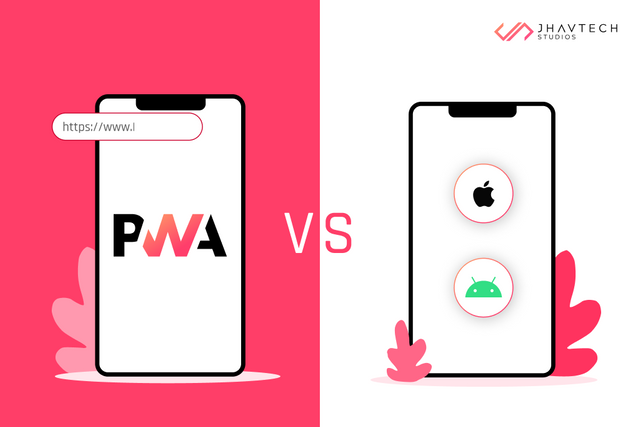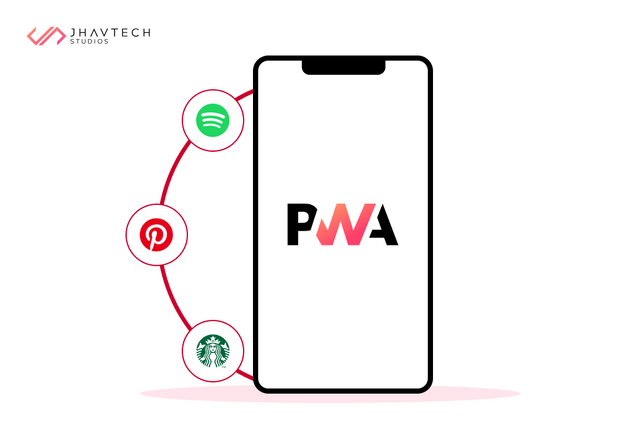PWA vs Native Application: Key Differences to Consider Before Building Your App

The progressive web apps vs native apps battle intrigues many developers and businesses. So, will progressive web apps replace native apps in the future? What is the difference between PWA and native apps? What are the strengths and weaknesses of PWAs and native apps? Keep reading this blog post to find out.
According to a report by Statista, smartphone subscriptions worldwide today surpass six billion. This number is predicted to grow further by several hundred million in the next few years. This creates an exciting opportunity for businesses to leverage the power of mobile apps to offer seamless user experiences. However, the last few years have seen rising support for progressive web apps (PWAs), and companies now face a pressing question: should they build a PWA or a native app?
Let’s explore the key differences between progressive web apps and native apps and determine which is better in 2024. Let’s get started!
Progressive Web Apps represent a significant evolution in the realm of application development, offering a versatile solution that bridges the gap between web and native apps. Unlike conventional native apps, PWAs are not bound by platform constraints, functioning seamlessly across various devices. They emulate the native app experience while retaining the accessibility and flexibility of a website. By leveraging modern web technologies, PWAs ensure a smooth and responsive user experience.
Moreover, PWAs provide the added advantage of easy installation directly onto the user's home screen, bypassing the need for app store downloads, thus highlighting a distinctive advantage over native apps in terms of accessibility and distribution channels. When comparing PWA apps vs native apps, PWAs' cross-platform compatibility and hassle-free installation process set them apart, offering a compelling alternative for developers and users alike.
Native apps, on the other hand, are applications that are built specifically for a particular platform, such as iOS or Android. They are installed on a user’s device through an app store, designed to take advantage of the device’s hardware and software capabilities. Native apps are built using specific programming languages and tools native to the platform, making them highly optimized for the platform they run on. When considering the choice between native app vs PWA, native apps excel in leveraging the full potential of a device's features and performance, thanks to their tailored development for a specific platform.
What are some PWA and native app examples?
Let’s take a look at them below.
PWA Examples:
Spotify: Spotify's PWA enhances user experience with faster speed, ad blocking, and a visually appealing design compared to its desktop app. Its unique interface dynamically changes backgrounds and is highly adaptable.
Pinterest: Pinterest's PWA is now a fast and data-friendly solution for users, featuring push notifications, low bandwidth usage, and offline capabilities.
Starbucks: Starbucks' mobile app was launched in 2015, but it wasn't suitable for markets in rural locations, where network connections are slow and patchy. Since Starbucks wanted people to browse their menus and add items to their cars even when they were offline, they developed the PWA app.
Forbes: Forbes saw vast potential in PWA and launched it in 2017. The Forbes website increased conversions and user engagement with its super-fast page loading, push notifications, instant transitions, and light design.

Native App Examples:
Airbnb: Airbnb is a digital marketplace for providing homestays, lodging, and tourism experiences. While Airbnb has been using other frameworks recently, React Native helped the company accelerate the development of its mobile app a few years ago.
Instagram: With over 1 billion monthly users, Instagram is among the most popular social media platforms. React Native was integrated into Instagram's platform in 2016.
Discord: Discord is a popular chat platform, utilized React Native for its iOS app, boasting millions of active users and a 4.8-star rating on the Apple app store.
SoundCloud: When SoundCloud was developing its app, the team encountered several difficulties, particularly finding iOS developers. So the company went with React Native, which was discovered as the best option.

Pros and Cons of Progressive Web Apps (PWAs):
When considering the comparison between native apps vs PWA, it's important to weigh the pros and cons of each approach.
Pros:
Cost-effective: PWAs require less development time and are easier to maintain, resulting in lower development costs than native apps.
Fast and responsive: They offer quick loading and a smooth user experience due to the service worker technology that enables offline usage and caching.
Cross-platform compatibility: PWAs are built using web standards and are accessible on any device or browser, including desktops, mobile, and tablets.
Lower storage requirements: They take up less space on a device than native apps.
SEO-friendly: PWA can be indexed by search engines like any other website, which means better visibility on search engine result pages (SERPs).
Secure: PWAs are secure as they follow HTTPS protocols and transmit encrypted information.
Cons:
Limited access to native device features: PWAs may be unable to access all of the features available on a user’s device, including push notifications, a camera, and an accelerometer.
Limited discoverability: PWA is not widely available on app stores like Google Play or Apple App Store.
Security risks: PWAs are vulnerable to cyberattacks and may require additional security measures to protect user data.
Limited user engagement: PWAs may not have the same engagement as native apps, such as social sharing or user-generated content.
Pros and Cons of Native Apps:
When analyzing the advantages and disadvantages of native apps vs PWA apps, it's crucial to delve into the specific attributes of each.
Pros:
Fast & efficient: Native apps are faster and more efficient compared to web apps as they are designed specifically for the platform they are running on.
Better user experience: They offer a better user experience as they can use the features and hardware of the device to their fullest potential.
High performance: Native apps can be accessed offline, providing better performance and stability.
Offline mode: They can use push notifications and provide offline data storage.
Accessible: Native apps can be downloaded from app stores, making it easy for users to discover and install the app.
Cons:
Slow time to market (TTM): Native apps require more resources and time to develop, requiring a separate version for each platform.
Frequent upgrades: Native apps must be updated and maintained separately for each platform.
Higher cost: The development cost of native apps is higher than web apps.
Lengthy downloading process: Native apps require users to download and install them, which can be a barrier to entry for some users.
Progressive web apps: Use cases
Offline Mode: PWAs can work offline, enabling users to access content and services even when they are not connected to the internet.
News and Media: Many news and media companies have adopted PWAs to deliver content to their audiences quickly and efficiently.
Travel and Hospitality: Companies in the travel and hospitality industry use PWAs to provide users with information about flights, hotels, and tourist attractions.
Banking and Finance: Banks and financial institutions use PWAs to offer their customers access to their accounts and financial services.
Health and Fitness: Health and fitness apps use PWAs to provide users with information about workouts, nutrition, and health tracking.
Native apps: Use cases
E-commerce: E-commerce companies use native apps to provide customers with a seamless shopping experience, including features like product browsing, checkout, and payment processing.
Social Media: Social media platforms use native apps to enable users to connect with friends, share content, and engage with their communities.
Gaming: Gaming companies use native apps to deliver high-quality gaming experiences to users, including graphics, sound, and gameplay.
Education: Educational institutions use native apps to deliver online courses, quizzes, and learning materials to students.
Productivity: Productivity apps use native apps to provide users with tools and features to help them be more productive, including task management, calendar, and note-taking apps.
Entertainment: Entertainment companies use native apps to deliver streaming video, music, and other content to users.

Progressive web apps vs Native apps: Which is better in 2024?
The choice between PWAs and native apps depends on various factors, including business goals, target audience, and required features. In 2024, PWAs offer a cost-effective solution with broader accessibility, quicker development cycles, and easier maintenance. However, when comparing PWA vs native app, native apps excel in providing a polished user experience, leveraging device capabilities for optimal performance.
Ultimately, the decision rests on careful evaluation of project requirements, resources, and timelines. Businesses must weigh the trade-offs between wider reach and refined user experience to determine the best fit for their mobile application needs.
The ongoing debate between PWAs and native apps continues to intrigue developers and businesses. While PWAs offer advantages like cost-effectiveness and cross-platform compatibility, native apps provide superior performance and user experience. The choice between PWAs and native apps depends on factors like business goals, target audience, and required features. By carefully evaluating these factors, businesses can determine the best fit for their mobile application needs in 2024.
Conclusion
In conclusion, the choice between PWAs and native apps depends on various factors such as business goals, target audience, and required features. While PWAs offer advantages like cost-effectiveness and cross-platform compatibility, native apps provide superior performance and user experience. Businesses must carefully evaluate these factors to determine the best fit for their mobile application needs in 2024.